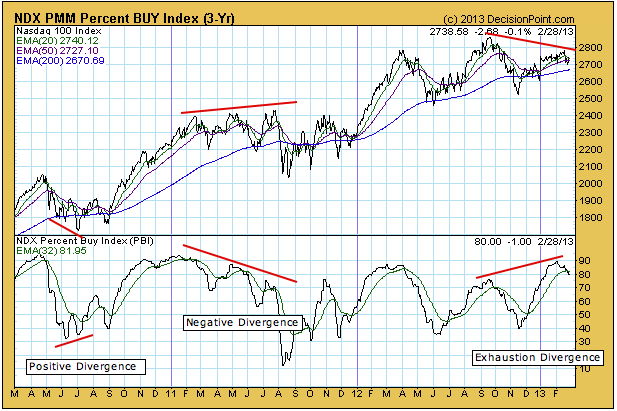Textbook dIvergences occur when an indicator fails to keep up with price. For example, a positive divergence is when price makes a lower bottom, but the indicator makes a higher bottom. A negative divergence is when price makes a higher top, but the indicator makes a lower top. In each case the divergence signals a possible price reversal. I call them "textbook" divergences because they are the kind that are typically referenced in any discussion, but there is another kind of divergence, which I will call an "exhaustion divergence," that is extremely useful but rarely mentioned.
Let me first apologize if the exhaustion divergence has been identified and named something else by someone else. I am not the most widely read person you will ever meet. But, since I do not recall ever having seen it included in a discussion of divergences (except by me), I will take the liberty of giving it a name for the purposes of this discussion. Also, I seriously doubt that I am the first to have noticed and remarked upon this type of divergence.
The exhaustion divergence is quite the opposite of the positive or negative divergence. In a rising trend, the price index makes a lower top while the indicator makes a higher top. And in a falling trend, price makes a higher bottom while the indicator makes a lower bottom. I believe it signals the exhaustion of the price move because internals are unable to drag price along with them.
On the chart below I have annotated examples of each type divergence. In 2010 we had a positive divergence which coincides with the price low. In 2011 two lower indicator tops precede the price break in July/August. And finally, the exhaustion divergence occurring at the most recent price top.
The significance of the divergence becomes more obvious when we understand the indicator. The Percent Buy Index (PBI) shows the percentage of Price Momentum Model (PMM) buy signals for all the stocks in a given index -- in this case the Nasdaq 100 Index. (The PMM generates mechanical medium- to long-term buy and sell signals for individual stocks.) At it's peak in January the PBI showed that 90% of stocks in the NDX were on buy signals (much higher than in September), yet price was struggling below it's previous top. it reminds me of a car with its engine turning at high RPM and the clutch slipping.
Since the NDX is a cap-weighted index, the cause of the divergence is that the larger-cap stocks in the index are not doing very well, not a heaalthy situation. In addition to the divergence you'll notice that the PBI has crossed down through its 32-EMA. This is a sign that a price correction may be about to take place.
Conclusion: My observation is that the exhaustion divergence is a reliable tool, probably more reliable than the positive divergence, which tends to be nullified during strong up trends. Currently, there are many indications that a price correction is due. This is just one more.







